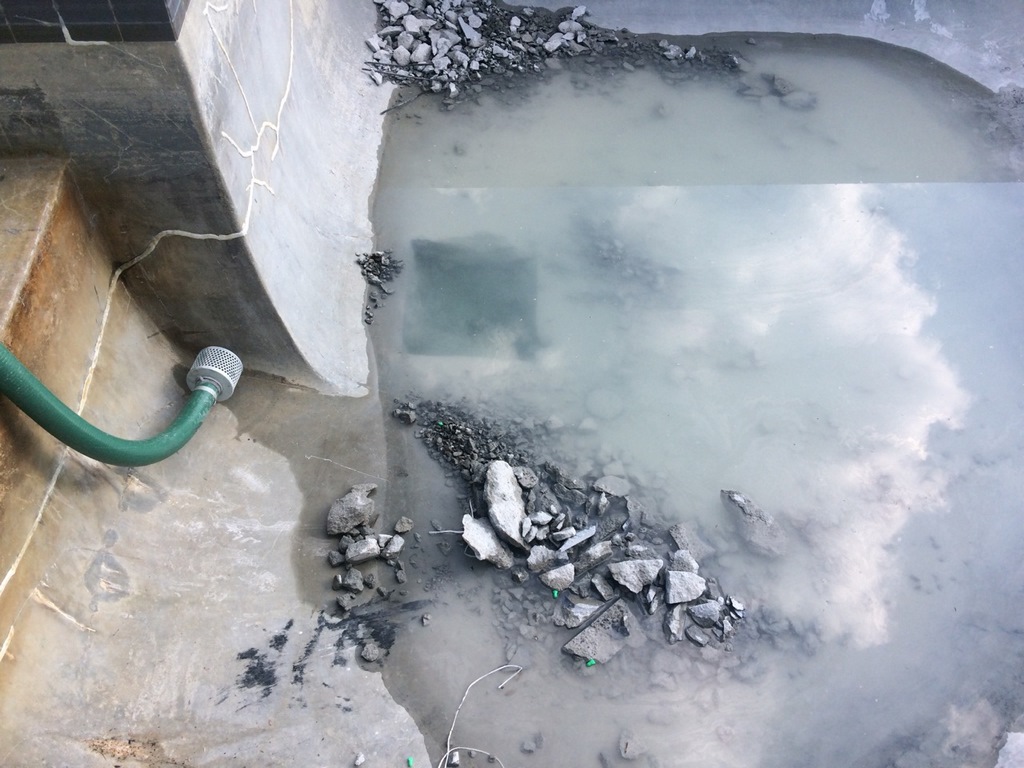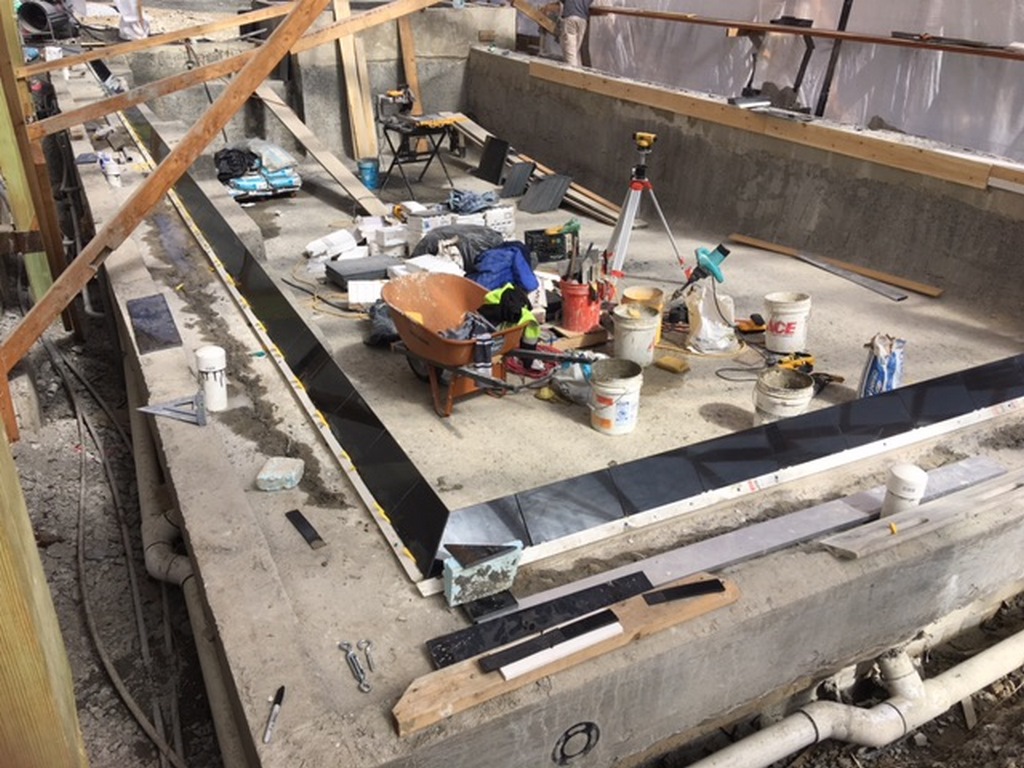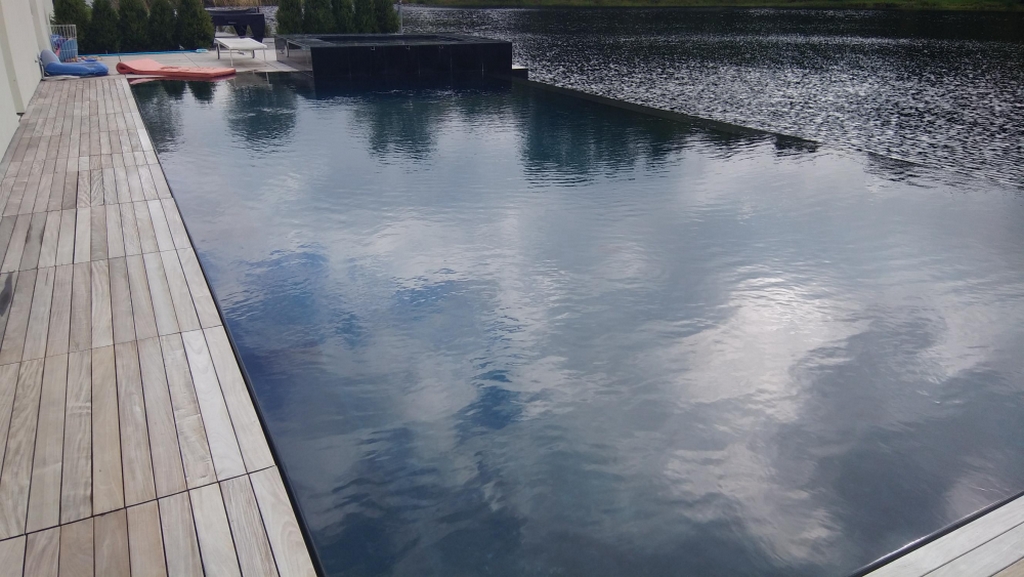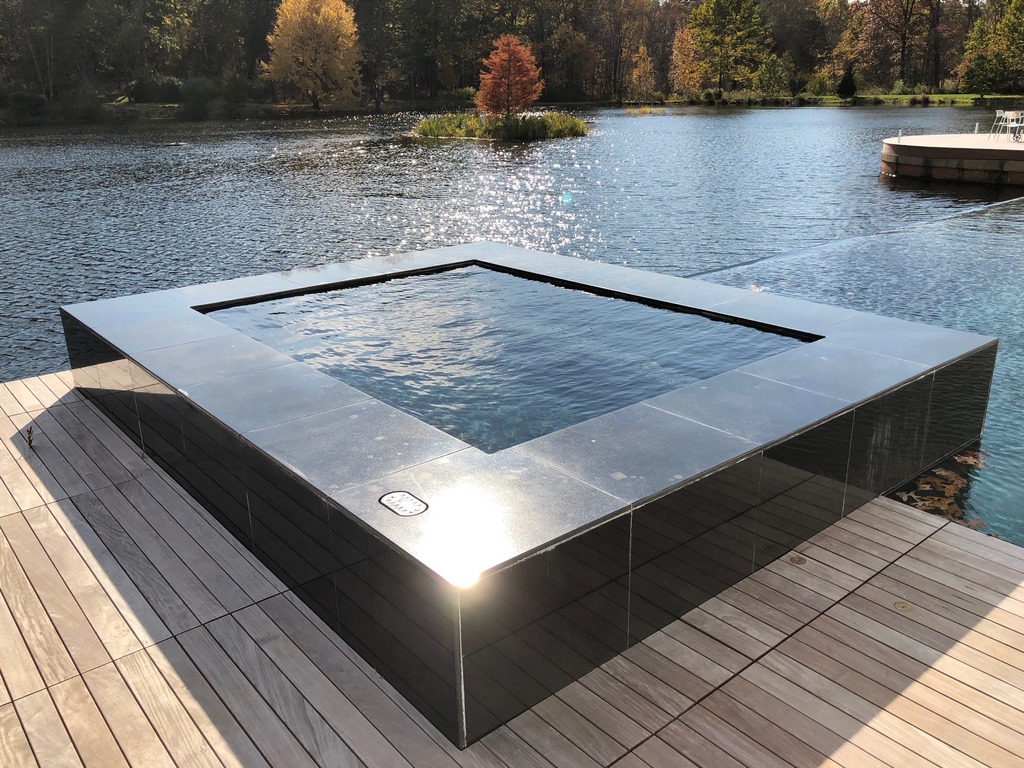Hard-Won Beauty

As we were wrapping up a WaterShapes article called “Working at Water’s Edge” back in the fall of 2018, it occurred to me that there was another story to be told about one of the projects highlighted in the text.
In that article (click here), a pool I wrote about was set up on the edge of a large, manmade lake. I briefly noted that I’d been called to the site as a consultant after having seen the place several years earlier as a designer/builder who hadn’t won the contract. In this article, I’ll go back to my initial contacts with the client and tell a fuller story of a trying relationship that, slowly and with great difficulty, worked out for the best.
On the client’s part, it’s a tale about looking for a deal and getting in trouble with an obviously complicated project. For me, it was a great object lesson – and, I think, a useful cautionary tale for watershapers who encounter similarly challenging situations.
STRAIGHT TALK
Back in 2008 or ’09, the client found Drakeley Pool Company (Bethlehem, Conn.) through a referral that positioned us as one of the area’s high-end design/build firms. He was a real-estate executive from New York City and was clearly not one who varnished his opinions.
In the introductory process, he’d met with three or four companies, and I seem to recall that we distinguished ourselves by insisting on the need for soils research and geotechnical analysis in view of the fact that the pool was to be set in a narrow space between the house and a seawall. We were familiar with the property manager and the home builder through other projects and figured they’d see and support the wisdom of our conservative approach.
Once we presented initial budget numbers and a game plan, I took the clear impression that the client stopped listening. Perhaps he had decided to disregard the caliber or reliability of our work? Or maybe (and more likely) he had a set figure in his head that we’d surpassed by too much.
Our portfolio was impressive, but this gentleman had lived for years in the rough-and-tumble world of New York realty. As a result, I imagine he had little faith that we were being realistic about what the project would involve and what it would cost. Whatever the case, we left the meeting with the clear impression that we weren’t the right fit.
Just the same, we followed up by phone and email as a courtesy. When no response was forthcoming, we took him off our prospect list and never heard from him or anyone else associated with the project again. Moreover, we weren’t even curious enough to try to get any information on the outcome: The whole matter slipped swiftly out of sight and out of mind.
Almost ten years passed, and the home builder called and asked me to come in as a consulting expert/designer-builder on a project that had gone south with a cracking pool that was only getting worse. As I mentioned, I had worked with this contractor on a number of other projects and didn’t recognize that this was that old lakeside pool until I reached the driveway and memories of previous visits flooded my thoughts.
I’d made the trip, so I proceeded to meet with the homeowner and the builder. Nothing had changed, with the client declaring almost immediately that he wasn’t looking to break the bank on repairs and further reporting that the pool had been troubled from the very start.
PREDICTABLE PATH
Essentially, we picked up right where we’d left off a decade earlier, with me asking him what the soil beneath the pool looked like and what sort of geotechnical precautions had been taken to secure its structure.
For his part, he believed the problem was bad concrete and a poor installation process, pointing to the cracks and noting that water was leaking through the shell in a number of places. As he was speaking, I noticed that the vanishing edge’s catch basin was too small and that, glancing at the equipment set, there was just one system driving both the pool and the edge.
There was also an unremarkable pool-level spa in one corner and, rounding out a pretty picture of ineptitude, a painted, “modernist” concrete decking that abutted the shell with no coping. I was then startled to notice that the top of the waterline tile rose to deck level in an unsuccessful attempt to achieve a look of water-level/deck-level equalization.
| After ten years of not thinking about this place, we found a pool that was breaking apart, a cracked spa, an undersized vanishing-edge trough and waterline tile pushed up to match the coping’s level. It took no time at all to determine that the whole installation needed to come out and be replaced by a new and properly engineered pool and spa. |
Moving past his opinion, I told him that the whole project was an irreparable failure, noticing all the while that he was getting more and more agitated with each non-shell-related defect I pointed out. He soon informed me that all the others who’d come in to have a look had said that repairs were possible – even simple – with a few patches and epoxy injections.
And here I was, telling him the pool had to come out because no repairs would last given the likelihood of detrimental soil conditions beneath the shell. In addition, I told him I was surprised that nobody else had ever insisted he get soils and geotechnical reports as a condition for bidding on the project – either new work or repairs. “Why,” I asked, “would any builder work on a pool set in lake water without serious geotechnical information?”
I could tell that he was finally starting to understand the gravity of the situation. I offered to get back to him with a design/consulting proposal and fee structure that covered all necessary reports, a new design and complete construction specifications. When they received it, the homeowner and builder indicated that the consulting contract was too costly – so I respectfully told them “no problem” and wished them luck with the project.
REVISITING CHAOS
The very next day, I received a call informing me that the client had reconsidered and wanted to move forward with my recommended course of action. With that in mind, he asked if I could lower some of my consulting fees; I reluctantly agreed.
We moved along, lining up the soils testing and analysis and, armed with the necessary engineering information, offering a complete set of design recommendations. Once the old pool was gone, we would install a slot perimeter-overflow pool with a raised spa and a vanishing edge on the lake side. This included Ipé decking with a deck-to-water elevation at minus one inch, meaning the water level would be set above the deck – a cool look we knew he’d like.
He agreed in principle to the design package, so we priced it all out. The homeowner responded that we were off the charts and that he was going to put the job out to bid with other builders – a move our consulting agreement clearly stated was his to make. “That’s fine,” I told him, and withdrew our proposal knowing that, as before, ours wouldn’t be the low bid.
| Once we’d cleared the space down to competent material, we set up a dewatering system and built up the void with properly compacted fill while taking all necessary steps to protect both the home’s foundation and the seawall. Water intrusion led us to include hydrostatic relief valves before moving on to complete the shell and prepare the perimeter-overflow system. |
As I said to the home builder, I didn’t think the client’s disposition and mine were a good fit and I was happy thinking I’d never hear another word about this project. I’d done my best and rested easy knowing that a competent pool builder could follow the plans and produce positive results.
About a week later, the home builder called and asked me to tackle the pool, adding that we’d need to be willing to renegotiate the whole package. I asked where the new bids had come in and heard that the one nearest was pegged at $70,000 less than ours.
He asked if we could meet in the middle. I explained that there was no way I could close the gap without cheating the process and lessening the integrity of the pool structure. He said he understood but needed something. So I said, “Fine. I’ll go halfway toward halfway.”
DIFFICULT BUT SATISFYING
Explaining why this project required special engineering (and the associated costs) was difficult. As designers and builders, however, it is our job to explain the reasoning behind these requirements, even if it’s not anything the client wants to hear.
In this case, I also knew from all of the history reported above that the client would never stop inquiring about the smallest details of our processes. But we moved steadily ahead, demolishing the old pool, clearing and dewatering the site and doing what was required to protect the home’s foundation and the seawall.
The soils tests had found stable material eight feet below the base of the pool, so we removed the old fill and replaced it with properly compacted material. It didn’t even require piers or beams or keys – really simple stuff, in other words.
As work progressed, however, we noticed that water intrusion was a constant factor, so we took the precaution of including several hydrostatic relief valves in the floor of the pool to stabilize it in the event of a power outage or some other failure of the dewatering system.
| The completed project is a beauty, with the pool’s water mirroring the appearance of the lake beyond. Better yet, the whole composition is engineered to withstand adverse soil conditions and will serve the homeowner through as many Memorial Day celebrations as he wants to host. |
Ultimately, the finished pool and spa wound up being a gorgeous addition to the client’s amazing Modern-style home. The dark-plaster finish mimicked the appearance of the adjacent lake, creating the illusion that the pool was an extension of that beautiful body of water. And we made our deadline: The new watershape was unveiled at the client’s annual Memorial Day party, serving as the focal point of his aquatic “backyard.”
My advice to any prospective client out there who wants a quality watershape: Take the time to listen and understand what needs to be done and why – and recognize and accept that cutting corners up front can cost you much more in the long run. My flip-side advice to quality watershapers: Take the time to educate your clients, doing what you can to help them understand what you need to do by offering clear examples from past experience and, through those stories, help them recognize the grim costs of skipping steps.
It may take large amounts of patience and persistence, but as this article demonstrates, it can help work things out to everyone’s long-term satisfaction.
William Drakeley is principal and owner of Drakeley Industries and Drakeley Pool Company in Bethlehem, Conn. He holds the distinction of being the first and only pool builder to sit as a voting member of the American Concrete Institute’s Committee 506 – Shotcrete and serves as secretary of the ACI C660 Nozzleman Certification Task Group. Drakeley is also an approved examiner for ACI-Certified Nozzlemen on behalf of the American Shotcrete Association (ASA), chairman of the ACI Pool Shotcrete Subcommittee, an ASA technical adviser and deputy director of the Genesis Educational Program. He teaches courses on shotcrete applications at the Genesis Construction School, World of Concrete and numerous other trade shows and is a contributor to Shotcrete Magazine and other industry publications.






















